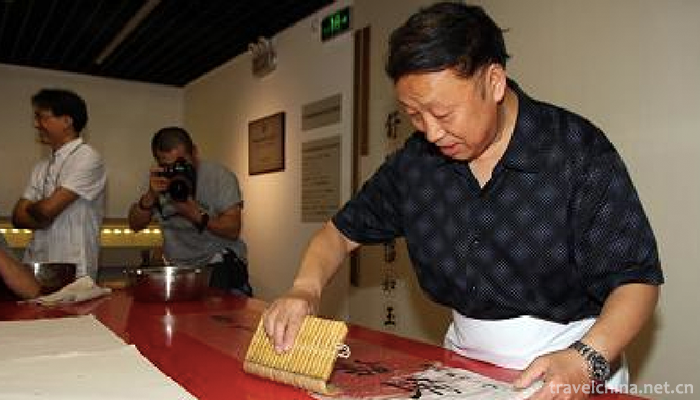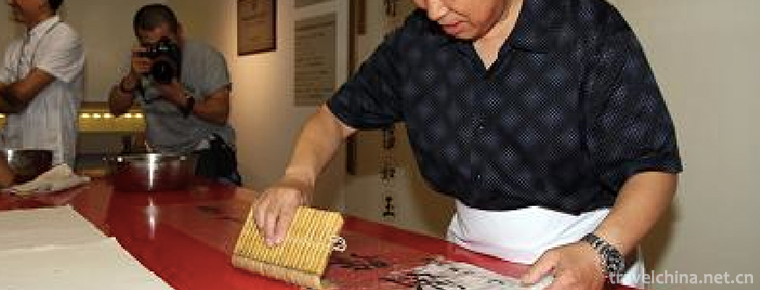Mounting and repairing techniques
Mounting and repairing techniques
The mounting and repairing technique of ancient Chinese characters and paintings is a kind of traditional Chinese handicraft. It is used for restoration and restoration of ancient calligraphy and painting treasures. Many paintings and calligraphy works of the past years have been damaged and broken because of improper preservation, falling off empty shells, or being damp and mouldy due to improper preservation. Most of these damages can be repaired, thus prolonging the life of the calligraphy and painting. This skill belongs to one of the national intangible cultural heritages.
brief introduction
In 2008, the mounting and repairing techniques of ancient calligraphy and paintings were included in 919_-136 items of the Second National List of Intangible Cultural Heritage.
One of the key problems for Chinese painting and calligraphy to be handed down from generation to generation is mounting and repairing. In the process of handing down ancient calligraphy and painting, due to poor collection and preservation, damp and mouldy, dirty, wormy bites, and natural aging of silk and paper will cause holes, decay and fracture in calligraphy and painting. If not repaired in time, it will affect the life and artistic value of ancient calligraphy and painting, and will rot and destroy once, However, the general collectors buy old calligraphy and painting, do not understand the importance of restoring old calligraphy and painting, we should know that ancient calligraphy and painting is a non-renewable work of art, if the restoration is not good, it will greatly discount, and even cause more serious damage to old calligraphy and painting, endanger the life of ancient calligraphy and painting, also weaken the art of ancient calligraphy and painting should have. Value. Today in museums, galleries, auctions and folk collectors, we can see that the ancient paintings and calligraphy of decades and centuries ago are masterpieces repaired and mounted by restorers.
The repair technology of ancient books is also called the binding repair technology of ancient books. Its history is closely related to the development history of books. Repairing damaged old books is a special skill. In order to do binding repair work, we should not only be familiar with the forms and editions of books of different dynasties, but also understand the paper, cover and binding style of each dynasty, and also have skilled skills. Repairing an ancient book often goes through more than a dozen processes, one trick and one style is extremely sophisticated, and the requirements for the personnel engaged in binding and repairing are almost harsh.
Origin
The art of painting and calligraphy mounting has a history of more than 2000 years, from the origin of silk painting in the Warring States Period and silk mural to the basic formation of silk painting axis in the Western Han Dynasty. From the archaeological data, the "Dragon Silk Painting of the Character" unearthed from the Chu Tomb of Hunan Warring States in 1973 provides valuable material for the study of the origin of painting and calligraphy mounting. Its "top horizontal edge is wrapped with a very thin bamboo strip, tied with brown silk rope." Later, on the silk paintings unearthed from No. 1 Han Tomb in Mawangdui, Changsha, it was further found that "a bamboo pole was wrapped around the top of the D-shaped silk paintings, tied with brown ribbons, and two lower corners of the middle and lower parts were all decorated with cylindrical ribbons made of fine linen thread." The above information can push the history of Chinese painting and calligraphy mounting to the Warring States Period more than 2000 years ago.
In the process of handing down ancient calligraphy and paintings, due to poor collection and preservation, dampness and mildew, stains, worms and rats bite, and natural aging of silk and paper will cause holes, decay and fracture in calligraphy and paintings. If not repaired in time, it will affect the life and artistic value of ancient calligraphy and paintings, which will rot and destroy once; However, the general collectors buy old calligraphy and painting, do not understand the importance of restoring old calligraphy and painting; we should know that ancient calligraphy and painting is a non-renewable work of art, if not restored well, it will greatly discount, and even cause more serious damage to old calligraphy and painting; endanger the life of ancient calligraphy and painting, but also weaken the art of ancient calligraphy and painting should have. Value. Today, in museums, art galleries, auctions and folk collectors can see decades, hundreds of years ago, the ancient paintings and calligraphy are repaired by restorers and mounted masterpieces. It can be seen how important the restoration of ancient paintings and calligraphy is to preserve cultural relics. Rehabilitation of ancient calligraphy and painting is a painstaking and delicate work with high difficulty, as well as a complex restoration technique.
Screens were prevalent in Qin and Han Dynasties. Screens were mounted to reinforce and protect them. Later, because of the need to preserve the paintings and calligraphy removed from the old screen, they developed into mounted paintings in a real sense. Hence, mounted paintings appeared in the Han Dynasty. Painting and calligraphy are mounted for protection and beauty. For emperors, they are mounted to show their dignity. In the pre-Qin Dynasty, there was a saying that "being the master, not beautiful or decorative, not enough for the people" (Xunzi Fuguo).


-
1.Shishi Sacred Heart Cathedral
Guangzhou Shishi Sacred Heart Cathedral is located in Yide Road
Time 2018-10-12 -
2.Pork intestine Noodles
Pork intestine Noodles are famous traditional snacks in Sichuan
Time 2018-10-12 -
3.Jingpo Lake
Jingbo Lake: National AAAAA-level tourist attractions, World Geopark, National Key Scenic Spots, International Ecotourism Resort, National Civilized Scenic Spots Demonstration Sites
Time 2018-12-05 -
4.Shui Guan the Great Wall
Shuiguan Great Wall is the eastern part of Badaling Great Wall. It was built at the mouth of dangerous valley. The Great Wall of Zishuimen Archery Tower is "V" shaped
Time 2019-02-13 -
5.Laiwu Bangzi
Laiwu Bangzi, also known as Laiwu Bangzi, is a unique opera in China. It has a history of more than 200 years and is a wonderful flower in traditional Chinese local operas.
Time 2019-05-10 -
6.Brewing Techniques of Shaoxing Yellow Rice Wine
Shaoxing has a long history of brewing wine, which can be traced back to the Spring and Autumn Period and the Warring States Period. By the time of the Northern and Southern Dynasties, it was well-kno
Time 2019-06-14 -
7.Tu Wedding
The custom of Tu people's wedding in Huzhu Tu area has a long history. Tu people's wedding custom is gradually formed and developed through the struggle with nature and the long-term practice of produ
Time 2019-06-23 -
8.down the mountain Yao Bu Yao Mai Cai Tik Tok Songs 2020 Hot Songs
"Down the mountain" is composed by Zhu bin. Yao Bu Yao Mai Cai to sing. It was released on November 22, 2019
Time 2020-05-21 -
9.Yele Nature Reserve
Yele Nature Reserve is located in Yele Township, north of Mianning County, Sichuan Province, bordering on the south of Shimian County, Ya'an City. It is a provincial nature reserve. It is 70 kilometers away from Mianning County.
Time 2020-10-16 -
10.Luodai Ancient Town
Luodai Ancient Town is located in Longquanyi District, Chengdu City, Sichuan Province, with a total area of more than 20000 square meters. Luodai Ancient Town is a national historical and cultural town and one of the five "Dongshan five fields" in Chengdu.
Time 2020-11-05 -
11.Nanchong hydrology
Nanchong is rich in precipitation. The average annual precipitation is 1000 mm, excluding evaporation, the annual total water is about 4.191 billion cubic meters, and the average annual runoff depth is about 313 mm. The distribution of runoff depth is generally
Time 2020-12-17 -
12.Meishan local culture
Meishan culture mainly includes Dongpo culture, longevity culture, Taoism culture, Buddhist culture, bamboo culture, water culture and so on. The past Meishan Dongpo Cultural Festival, Pengzu Shouxing Festival, Qingshen bamboo weaving art festival, Danling suona Festival, etc.
Time 2020-12-18